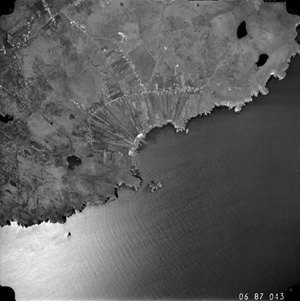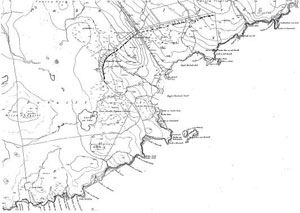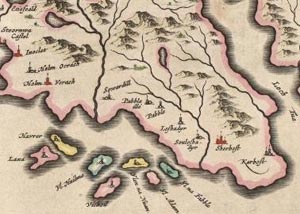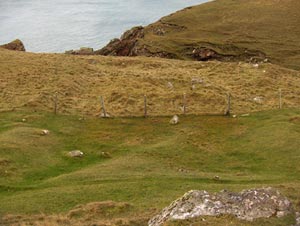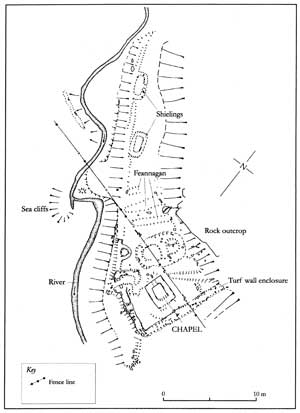
HEBRIDES: H6. Bayble/Pabail See inventory of place-names in the vicinity of Bayble/Pabail (Ui, Stornoway, Lewis) in Place-Name Appendix H6 · Introduction centred NG 6737 2715 Upper Bayble/Pabail Uarach centred NB 5315 3718 NMRS no. NB52W 1
The townships of Upper and Lower Pabail/Bayble (on some earlier maps written 'Bible' or 'Fabill'), lie on the south side of the Eye peninsula, to the east of Stornoway in Lewis. Two small islands - Eilean mòr Phabaill and Eilean beàg Phabaill - lie at the south end of Pabail bay, with a single island, Eilean a Chàise (Cheese Island), at the north end (Figs. H6.1 and H6.2). To the west and the north east of the bay, the coastline extends as a series of cliffs, punctuated by small bays and inlets. Gob na Creige (Ceann na Circ on the OS First edition map) or Chicken Head, c. 3.4km west of the Pabail islands, defines the southernmost point of the Eye peninsula. When sailing up the east side of Lewis, Gob na Creige - and the little offshore island of Eilean na Crotach, which lies midway between the headland and Pabail - form two of the principal landmarks. Just to the east of Eilean na Crotach, on the edge of the cliffs, is an unnamed chapel (c. 2.5km west of the Pabail islands), the only site of ecclesiastical significance on the lands of Pabail and close to its boundary with Suardail, the next township to the west.
Pabail has the Old Norse name equivalent to Papil in the Northern Isles (see Orkney and Shetland), derived from papa-býli (= 'dwelling of the priests'). It is situated on one of the few parcels of better land on the peninsula, a feature first commented on by Headrick in 1800: THE SOIL OF LEWIS is mostly moss upon rock. . The only exception to this remark is a stripe of land from the peninsula of Aignish to Garrabost, and some patches near Bible, where the subsoil is of a marly quality, which resists the growth of moss above it, except where the surface is naturally wet (Headrick 1800, 7). Gneiss is the underlying rock of most of the Eye peninsula, with conglomerates lying to the west of Gob na Creige and extending further west across the isthmus. In contrast to the blanket peat which covers much of the interior of the peninsula, extending in a broad swathe down to Gob na Creige, drift deposits have built up across a roughly circular area at the back of Pabail bay, their southern boundary defined by the Allt Driseach, which drains from Loch an Dùn, between the south end of Pabail Iarach and the coast. The northern and eastern boundaries are harder to define, but are probably close to those of the present extent of croft land. The drift deposits have produced gleys and podzols capable of growing crops and maintaining improved grassland (in modern land capability terms classified as 4/1 and 5/1). In a Forfeited Estate rental of 1718, most of the lands on the peninsula were let as individual farms, apart from Pabail Iarach, which had been divided up amongst small tenants; however, by 1754, the latter was back in the hands of a single tacksman, with eleven sub-tenants (Lawson 1991b, 17, 19, 21). In the early nineteenth century, Pabail Iarach had 53 inhabitants and Pabail Uarach, 93 (ibid., 26). According to the first OS surveyors, both were merely 'small and filthy' villages, partly inhabited by fishermen (Ordnance Survey 1849, 1851, Original Object Name Books, Ross-shire, Book 75, 13, 15). The OS First edition map and the aerial photographs show nucleated groups of buildings located downslope of the later crofting townships, which lie on the slightly better soils set back from the shore (Fig. H6.2). There is a dun close to the east shore of Loch an Dùn (NMRS no. NB53SW 6, SMR no. 434, NB 51682 30437), while the standing stone of Clach Stein lies to the north (NMRS no. NB53SW 5, SMR no. 433, NB 5165 3174), both reinforcing the impression that the importance of this area for settlement is of long standing.
The first mention of the name is by Dean Monro in 1549: At the shore of Sky foresaid, lyes ane iyle callit Pabay, neyre ane myle in lenthe, full of woodes, guid for fishing, and a main shelter for theives and cut-throats. It perteins to M'Kynnoun (Monro 1549 (1994), 505). Dean Monro's description is ordered geographically; the Pygmies Isle lies at the north end of Lewis, so that Fabill is the first place mentioned along the east coast. It is possible that he is referring to the whole of the Eye peninsula as an island, since the two Pabaill islands would seem far too small to warrant this description. Eilean Mor Phabail is first mentioned in the texts accompanying Blaeu's atlas of 1654, although again the sense is not quite clear: From this same coast Eilean Mor Phabail turns more to the mid-day light . (Melville 1603-4, f.10v) Blaeu shows a number of small islands, including Yl na Fabble, off this stretch of the east coast of Lewis - far more than there are in reality (Fig. H6.3). In addition, Pabble and Pabble Ille appear on the Eye peninsula, some distance to the west of Yl na Fabble. Like Blaeu, many of the early maps show a number of islands along the east coast of Lewis, which are now difficult to identify - but which perhaps include the Pabail islands. They are first recognisable on Dorret's map of 1750, when Eilean na Crotach and ?Eilean mòr Phabaill (but not Eilean beàg Phabaill) are depicted, but not named. Mackenzie's map of 1776 does show the two Pabail islands, but the headland immediately behind them is named as Chicken Head, while Bible Head lies to the east of 'Bible' itself (Fig. H6.4). The frequency of the English versions of the names - particularly Bible for Pabail suggests that these maps were primarily intended for English-speakers, while it is possible that further confusion has arisen from differing perceptions from sea and land. In spite of its close proximity to Stornoway this part of the Eye peninsula appears remote from the landward side, or at least difficult of access, as indicated by the story behind Leabaith a Mhinnister, 'the Minister's Bed', just to the east of Gob na Creige: A Point of Land on the sea shore the name of this place originates from the circumstance of a minister having taken shelter here for many weeks from the enemy at the Period of the Persecution of the Covenanters. There is no way of getting to this place unless by water as the rocks project over it which secures it from the Eye of persons walking along the High Water Mark (Ordnance Survey 1849/1851, Original Object Name Books, Ross-shire, Book 74, 49). At the far (south) end of Lower Bayble is the township of Eagleton. Though a relatively late foundation, the name of which has been translated directly into Gaelic as Baile na Iolaire, 'the settlement of the eagle', there is a possibility that it derives from Gaelic eaglais, 'church' (Carol Knott, pers. comm.). The small shingle beach to the east of the pier (NB 5291 3103), which divides Bayble Bay in half, is known locally as Papastaidh, perhaps incorporating the ON element støth, 'landing place'. An, as yet unlocated, tidal islet nearby is called Eilean na Mairbh, 'Island of the dead'. The proximity of these place-names to the Pabail islands is intriguing, suggesting perhaps that the early focus of activity was at the south end of the bay.
The number of names which appear on the OS First edition map along the south coast of the Eye peninsula is striking (Fig. H6.2). In light of this it is perhaps also significant that the surveyors could not find a dedication for the chapel that lies midway along its length, although it has given its name to a number of the surrounding topographical features. The chapel is described simply as: The ruins of a small building on the sea shore near Ceann na Cearc. Tradition says it was a Catholic Chapel at some period, there is nothing visible that would lead to that conclusion, but the ruins of what seem to have been a small hut (Ordnance Survey 1849/1851, Original Object Name Books, Ross-shire, Book 74, 25). However, in association with Ath an Teampuill, 'the Teampull Kiln', the bay below the chapel, traditions are recorded in the Name Book: A small Bay or Creek on the sea shore, on the edge of this Bay there is still to be seen the remains of an old church yard in the centre of which stands the ruins of an old house which tradition says was built by a Brother and Sister who having had connection with each other were Banished from the North part of the Island and came here for refuge. Afterwards a child was born which they threw into this place, from this circumstance the name originated. There is a small stream flowing from Loch Cuilc into this creek (Ordnance Survey 1849/1851, Original Object Name Books, Ross-shire, Book 74, 44). Though the ath element in the name is given as 'kiln' by the early OS surveyors, perhaps deriving from an actual (corn) kiln, it is equally possible - since no trace of a kiln can now be found in the vicinity - that the shape of the bay has given rise to the name. Equally, it may refer to a ford across the burn, allowing access to the chapel from the west (Carol Knott, pers. comm.). The site is known locally either as Tigh an t-Sagairt, 'The Priest's House', or Uaighe nighean an t-Sagairt, 'the grave of the priest's daughter', both of which could refer back to this story (Barrowman 2005, 68, Site 28). While it is possible that Chicken Head does represent a direct translation of Ceann na Cearc (cearc = hen), it could also derive its name from the Gaelic word circ, from kirk or church (ibid.). This uncertainty is reflected in a pencil note added to the Name Book: Hen Head? Chicken Head? Ceann na Ceàrc - or Circ is the Gaelic name and applied by the inhabitants - Chicken Head is English, used only by seamen, Charts, &c - Chicken Head is not a translation of Ceann na Cearc (Ordnance Survey 1849/1851, Original Object Name Books, Ross-shire, Book 74, 25). Loch Cuilc, the 'loch of the reed', which lies to the north east of the chapel, forms the boundary between the lands of Pabail and Suardail (Fig. H6.5). To the north of the loch, the boundary runs up and over the shoulder of Beinn Phabail, the highest point of the Eye peninsula. The stream draining the loch runs right past the chapel, before disappearing over the cliff edge. The discovery of handmade pottery in 1924, decorated by impressions of a swivel-ring headed pin of a type dated by Stevenson to between the seventh and tenth centuries, does suggest that the site could go back to the Early Medieval period (PSAS 1924, 14; Stevenson 1955, 292; Young 1955, 94). However, as the site is not mentioned until the time of the first Ordnance Survey, there is little to provide a context for the chapel. The RCAHMS Inventory (1928) provides the first, more detailed description of the chapel and its surroundings: About 5/8 mile, east of Chicken Head, in a small enclosure on the left bank of a small rivulet near the edge of a cliff which rises more than 100 feet out of the sea, are the foundations of a stone and mud building measuring about 18 feet in length and 15 feet in breadth, orientated west-north-west and east-south-east. In the vicinity are the foundations of other structures, which have the appearance of ruined shielings (RCAHMS 1928, 14, no. 44). This description is confirmed by more recent accounts: The walls are well-built, some of the stone being roughly dressed, and are 3ft 9 ins. thick. The entrance is not evident. The building stands in a rectangular garth, as shown on OS1/2500 map, bounded on the north by a rock outcrop. Its east and south walls are evident, but its west wall has been destroyed by the superimposition of five shieling-type structures, which have presumably used it as a quarry (Information contained in NMRS record, based on site visit of 22 April 1964 by OS assistant archaeology officer). and: The footings of the single chambered oblong chapel are no more than 0.5m high. It is orientated WNW and ESE measuring 6.6m by 5.1m externally over walls 1.2m to 1.6m thick. The walls are well built of large roughly dressed stones. Surrounding the chapel are the remains of a rectangular wall of turf and stone. The wall is well defined in the south (15.5m from the chapel) and east (23.5m) where it runs uphill to end at a rock outcrop. The wall is obscured in the west where later shieling huts have utilised its material. The edge of the stream bank, where it forms the boundary of the enclosure, has been built up with earth and stones (Information from HS scheduling document 1992, contained in NMRS record). In 2000, a survey of the chapel was carried out by Carol Knott and the Lewis and Harris Archaeology Group (Figs. H6.6 and H6.7). This revealed an entrance gap in the centre of the west wall, contrary to earlier descriptions, and that the east gable is less well-defined than the other walls, all of which appear as grassy banks. Like St. Peter's on Pabaigh Mòr (see H1), the chapel does not lie on an exact east-west alignment and it does not appear to have ever possessed a chancel. The enclosure is not much wider than the long axis of the building but it does extend much further to the south and the north. Two buildings clearly overlie the line of the west wall of the graveyard, while it is not apparent whether there was ever a wall at the base of a rock outcrop on the north side, where the rock itself probably renders a wall unnecessary (Carol Knott, pers. comm.). Further buildings, as well as lazybeds, lie to the north of the graveyard. Those furthest away from the chapel may be shieling huts; 'old shielings' are also noted on the modern OS map on the west side of the burn. However, the cellular form of some of these structures suggests that they may be of early date, and, on the basis of surface evidence, the site has characteristics typical of an Early Christian monastic settlement (Barrowman 2005, 68). Both its distance from the present centres of settlement and the traditions recorded in the OS Name Book (see above) may hint at the fact that this site was always thought of as a place apart; it is now little known to local people (ibid., 69). There is a dramatic rocky pinnacle next to the burn running to the west of the chapel, approached by a narrow path from the site, on which local people remember seeing a stone-lined grave, though this cannot be identified now (Carol Knott, pers. comm.). It is possible that this could be a place reserved for private retreat and contemplation. Geodha na Sitheannan, an inlet to the east of the chapel, although translated in the Name Books as 'Creek of the Flowers', is probably derived from the Gaelic for fairy and is one of only a few names along this length of coast which is not purely descriptive or associated with a particular individual (Ordnance Survey 1849/1851, Original Object Name Books, Ross-shire, Book 75, 39).
Pabail lies in the parish of Ui or Eye, now more generally called Stornoway, where the parish church is now situated. The Reverend John Cameron, the author of the second Statistical Account, states that the parish was divided into three districts: Certain it is, that the only place of worship in the parish was built on an isthmus. But, from time out of memory, the parish consisted of three districts, viz. Stornoway, Gress, and Ui. In each district, there was a place of worship erected ; and the ruined walls of two chapels are still remaining, one at Ui, the other at Gress. It was only within the last forty years, that the ancient place of worship in Stornoway was levelled, for the purpose of building a safer and more commodious church for the increasing population. The church of Stornoway was dedicated to St Lennan, that of Ui to St Collum, and that of Gress to St Aula. In the district of Ui, the ruins of another chapel are visible ; it was dedicated to St Cowstan. All these churches were sanctuaries in ancient times within the walls of which all criminals were safe.-(Vide Martin's Account.) (Cameron 1833, 115). Ui appears to have remained as an independent parsonage until immediately prior to the Reformation (Mackenzie 1903, 521; Cowan 1967, 64). The former parish church of Ui, dedicated to St. Columba and under the patronage of the Macleods of Lewis, was the principal church of Lewis throughout the medieval and early modern period. The last service was held there in 1828, after which it was replaced by the government church at Knock (FES vii, 202). The last person to be buried inside the church, around 1900, was a Margaret Macleod of Bayble (Anon. c.1960, 35). Margaret Macleod was well over 100 years of age, but the reasons for her burial within the church are not known. In spite of its generally accepted dedication to Columba, the site at Ui was believed by W. C. Mackenzie to have traditionally been founded by St. Catan in the sixth or seventh century (Mackenzie 1919, 137; the OPS places this church in Stornoway, perhaps picking up on Martin Martin's mention of a 'Stornvay Church', but it is possible that it could refer to Teampull Rubha Chirc (1703 (2003), 28; OPS, 381-2; Carol Knott, pers. comm.)). Though the site has now been re-developed, the Lennan dedication of the church in Stornoway may represent a corruption of Adamnan and may point to the influence of Iona in Lewis. In contrast, St. Aula or St. Olaf's at Gress, to the north west of the Eye peninsula, is the only certain Norse dedication in the Long Island. The other chapel mentioned by Cameron - that of St. Cowstan or St. Constantine, in Gaelic Teampull Chùistein, at Garrabost - is also located on the Eye peninsula, to the north of Pabail. In addition to these, Martin Martin notes the existence of St. Michael's chapel at Tolsta, but not the chapel at Pabail (1703 (2003), 27). During the medieval period, there appear to have been only four parishes in Lewis, declining to two - Barvas and Ui - after the Reformation (Monro 1549 (1994), 521; Martin Martin 1703 (2003), 27-8; Mackenzie 1903, 524; Cowan 1967, 64, 136). The probable pre-Reformation chapels in what is now the parish of Lochs, the south east part of Lewis, should therefore also be included in the inventory of the chapels of Ui. These comprise the important site of Eilean Chaluim Chille in Loch Erisort, another possible Columba dedication on the Shiant Isles, alongside the more probable Mary dedication and the annat place-name, the unlocated 'St Pharaer in Kaerness' mentioned by Martin Martin and an unnamed chapel at Rànais (Barrowman 2005, Sites 22-24, 32-34). This presents a picture of a dense network of local chapels in the Early Medieval period, into which the chapel at Teampull Rubha Chirc could fit. However, the cluster of names of potentially ecclesiastical significance, preserved only in local tradition, at the south end of Bayble Bay, hints at the possibility that the core of the papar site was Pabail itself; if so, perhaps Teampull Rubha Chirc was more closely associated with an eremitical site.
OS Maps
The papa-býli places in the Hebrides are a different entity from the Pabbay islands, and not easy to define. We are still not certain what the býli/bol element signifies, or whether indeed this is the correct derivation of the name (see discussion 2.3 'Linguistic Evidence' in 'The Papar Project. Inception, Parameters and Purpose' in the Project Introduction). But it certainly is likely to signify settlement of some sort, in contrast to the island names of Pabaigh/Pabbay, where settlement has to be assumed (and is indeed sometimes evidenced by Norse settlement names). The strategic location of these places has already been assessed (see Introduction to the Hebrides), and Bayble/Pabail on the Eye peninsula is a notable example, located as it is at the northern end of the Minch. Moreover it is extremely accessible from the seaway, sticking out from the coast of Lewis, and controlling access into the sheltered harbour of Stornoway. The usual criteria of Pabbay islands is significant here also, for this part of the Eye peninsula is remarkable for being so fertile compared with the rest of Lewis. Indeed, the Soil Survey rating of 4/1 is the highest of any 'papar' place in the Hebrides, and the only one which attains to the high rating of 'papar' places in the Northern Isles. Any ecclesiastical connection is, however, hard to find, and there is no surviving early Christian sculpture from any part of the Eye peninsula (or indeed from any part of the island of Lewis). Strategic significance and fertility of soil are the two important, and relevant, factors here. |
|||||||||||||

